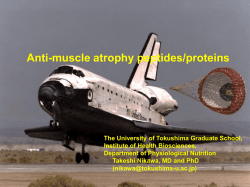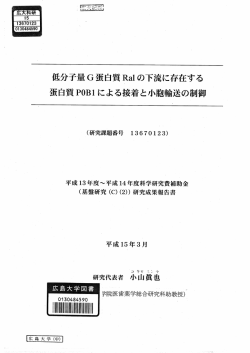
大豆たん白質食の抗筋萎縮効果 ―培養細胞実験からヒト介入試験まで
大豆たん白質食の抗筋萎縮効果 ―培養細胞実験からヒト介入試験まで― 二川 健* 徳島大学大学院ヘルスバイオサイエンス研究部生体栄養学 Anti-Muscle Atrophy Action of Dietary Soy Proteins Takeshi NIKAWA* Department of Nutritional Physiology, Institute of Health Biology, The University of Tokushima Graduate School, Tokushima 770-8503 ABSTRACT Background: Unloading stress induces skeletal muscle atrophy. We have reported that Cbl-b ubiquitin ligase is a master regulator of unloading-associated muscle atrophy. The present study was designed to elucidate whether dietary soy glycinin protein prevents denervation-mediated muscle atrophy, based on the presence of peptides inhibiting Cbl-b ubiquitin ligase in soy glycinin protein. Methods Mice were fed either 20% casein diet, 20% soy protein isolate diet, 10% glycinin diet containing 10% casein, or 20% glycinin diet. One week later, the right sciatic nerve was cut. The wet weight, cross sectional area (CSA), IGF-1 signaling, and atrogene expression in hindlimb muscles were examined at 1, 3, 3.5, or 4 days after denervation. Results: The 20% soy glycinin diet significantly prevented denervationinduced decreases in muscle wet weight and myofiber CSA. Furthermore, dietary soy protein inhibited denervation-induced ubiquitination and degradation of IRS1 in the tibialis anterior muscle. Dietary soy glycinin partially suppressed the denervation-mediated expression of atrogenes, such as MAFbx/atrogin-1 and MuRF-1, through the protection of IGF-1 signaling estimated by phosphorylation of Akt-1. Conclusions: Soy glycinin contains a functional inhibitory sequence against muscle-atrophy-associated ubiquitin ligase Cbl-b. Dietary soy glycinin protein significantly prevented muscle atrophy after denervation in mice. Soy Protein Research, Japan 16, 99-103, 2013. Key words : Soy Protein, Muscle Atrophy, Ubiquitin Ligase Inhibitor * 〒770-8503 徳島市蔵本町3-18-15 大豆たん白質研究 Vol. 16(2013) 99 近年,急速に高齢化の進む我国では寝たきりや運動 いので阻害剤を検出するのに非常に便利である.SPI, 不足による筋萎縮(サルコペニア)が大きな社会問題 コングリシニン,グリシニンと脂質たん白質群由来の となっている.我々は,これら筋肉の廃用性萎縮がユ 同量のペプチドによるユビキチン化阻害を検討した ビキチンリガーゼ(注:筋たん白質のユビキチン化を ところ,Fig. 3に示すように,グリシニン由来のペプ 触媒する酵素であり,分解すべきたん白質にポリユビ チドはCbl-bによるIRS-1のユビキチン化を阻害した5). キチンというタグを連結する反応を触媒する)の活性 グリシニン由来ペプチドの抗ユビキチン化作用は, 化による筋たん白質分解の促進によることを明らかに Heck細胞またはCOS7細胞系を用いたユビキチン化シ した1).ユビキチンリガーゼを欠損させたマウスは廃 ステムでも観察された(Fig. 4).興味深いことに,グ 用性筋萎縮になりにくいことから,廃用性筋萎縮の治 リシニンを多く含むたん白質食材は,in vivo 実験にお 療にはこのユビキチンリガーゼの活性を阻害すること いても坐骨神経切除によるIRS-1の分解を抑制するこ が有効であると考えられる2, 3).しかし,ユビキチンリ とがわかった(Fig. 5) . ガーゼ阻害物質はほとんど報告されていない.ユビキ チンリガーゼは基質たん白質の一部分(ペプチド)を チドにはユビキチンリガーゼと基質たん白質との結合 を阻害できるのではないかと考えられた(Fig. 1).そ の結果,これまでに大豆たん白質由来のペプチドなど に数種のユビキチンリガーゼ阻害ペプチドを見いだし た.これまでにも,大豆ペプチドが運動による筋傷害 の軽減に有益であるとの報告4)があり,大豆ペプチド Ubiquitination Ub Ub Ubiquitin ligase (Cbl-b) 認識して結合するので,ある特殊な配列を有するペプ Ub Ub Ub Ub Ub Ub Ub Ub Ub Ub E2 IRS Ub Ub Ub E2 IRS IRS は骨格筋に特異的な作用を有するのではないかと期待 方法と結果 大豆ペプチドによるIRS-1ユビキチン化阻害 廃用性筋萎縮で発現の増大するユビキチンリガーゼ Fig. 1. Peptide-mediated inhibition of ubiquitin ligase. insulin/IGF-1 receptor Bed-rest Spaceflight Cbl-bは,萎縮筋におけるIRS-1のユビキチン化と分解 p p p p 2) を促進してIGF-1シグナルを調節している(Fig. 2) . Cbl-b遺伝子を欠損すると尾部懸垂による筋萎縮に抵 PI3K た.前項の原理に基づき,Cbl-bによるIRS-1のユビキ チン化阻害活性が大豆ペプチド群に存在するかを検討 Cbl-b Ub Ub Ub Akt/PKB GSK3 S6K mTOR FOXO Nucleus Muscle atrophy-associated genes (Atrogin-1, MuRF-1 etc) した.分離大豆たん白質(SPI: soy protein isolate)は, 主にグリシニン(11S),コンゴリシニン(7S)と脂質 IRS-1 5Ub 0 p8 UbUb p11 抗性を示すことから,Cbl-bのユビキチン化活性を抑 制することが筋萎縮を予防できる一つの手段と考え Increase in muscle protein synthesis peptide Muscle atrophy されている. Activation of Insulin/IGF-1 signaling Degradation by proteasome Protein synthesis Protein degradation たん白質(LP)群の3種類のたん白質からなる.そこ で,それぞれを酵素処理しペプチド化したものをCellfree ubiquitination systemに供した. Cell-free ubiquitination systemを 簡 単 に 説 明 す る. たん白質のユビキチン化経路はユビキチン活性化酵素 (E1) ,ユビキチン結合酵素(E2)とユビキチンリガー ゼ(E3)の酵素群からなり細胞質内で行われる.お もしろいことに,基質とこれら酵素群を試験内で反応 させることにより細胞内のユビキチン化を再現するこ とができる.この反応系は,雑多なたん白質を含まな 100 Fig. 2. Mechanistic model of unloading-mediated muscle atrophy. Unloading induces ubiquitin ligase Cbl-b in myocytes. Cbl-b stiumulates ubiquitination and the degradation of IRS-1, an important intermediate in IGF-1 signaling pathway, resulting in IGF-1 resistance in myocytes during unloading. IGF-1 resistance induces impaired protein synthesis and enhances protein degradation in muscle, leading to muscle atrophy. 大豆たん白質研究 Vol. 16(2013) IRS-1 (Substrate): Cbl-b (E3): E1: UbcH7 (E2): GST-Ub: Peptides: + + + - + + + + + + + + + + - SPI + + + + + LP + + + + + C IRS-1 (Substrate): Cbl-b (E3): Ubquitin-FLAG: Casein-derived peptides (μg/mL): Glycinin-derived peptides (μg/mL): + + + + + G + + + + + + + + + + + 0 60 60 0 0 10 20 0 IP: IRS-1-V5 MMSTD (kDa) MMSTD (kDa) IB: Ub-FLAG UbIRS-1 IB: IRS-1 200 200 IB: Cbl-b-HA 120 IB: IRS-1-V5 180 IRS-1 180 Fig. 3. Inhibitory effect of soy-glycinin-derived peptides on Cbl-b-mediated IRS-1 ubiquitination. (I) Purified soy protein isolate (SPI), lipoprotein (LP), soy glycinin (G), and soy β-conglycinin (C) were digested with trypsin, then 20μg/ mL of each of the hydrolysates was subjected to cell-free ubiquitination assay to elucidate their inhibitory effects on Cbl-b-mediated IRS-1 ubiquitination. A Fig. 4. Inhibitory effect of soy-glycinin-derived peptides on Cbl-b-mediated IRS-1 ubiquitination. (II) HEK293 cells transfected with mock vector/pCEFL-Cbl-b-HA, pcDNA3.1-rat IRS1-V5, and pcDNA3-FLAG-Ubiquitin were treated with the indicated concentration of casein-derived (control) or soy-glycinin-derived peptides for 2 hours in the presence of 100 nM epoxomicin and 10 ng/mL IGF-1. Cell lysates from these cells were immunoprecipitated with an anti-V5 antibody. The immunoprecipitates were subjected to immunoblot (IB) analysis for the indicated proteins. MMSTD: molecular mass standards. Representative findings of three experiments with matching results. B Control Sham 1 3 Denervation Sham Denervation IB: IRS-1 Denervation 0 20% Glycinin 4 (day) IB: Actin IB: IRS-1 □ Sham IB: Actin IRS-1/Actin 1.5 ■ Denervation *, # 1 * 0.5 0 Control 20% Glycinin Fig. 5. Effects of dietary soy glycinin protein on IGF-1 signaling in denervated muscle. (A, B) The right and left legs of C57BL/6 mice were subjected to denervation and sham operation, respectively. The mice were fed with 20% casein (control) or 20% soy glycinin diet from1 week before denervation till the end of the experiment. TA muscles were isolated at days 1, 3, 3.5, and 4 after denervation. Homogenates of TA muscles isolated were subjected to immunoblotting (IB) for IRS-1 and actin on the indicated days after denervation. 大豆たん白質研究 Vol. 16(2013) 101 合成ペプチドによるCbl-bによるユビキチン化阻害 あると考え,研究を進めた結果,その部分の合成ペプ (Cblin: Cbl inhibitor) チドはユビキチンリガーゼCbl-bの活性を抑制するこ Cbl-bは,主に基質たん白質のリン酸化チロシン残 とが確認できた(データを示さず)5).その結果,大豆 基を認識して結合する.上記のように既存のたん白 ペプチドは少なくともこの機能性を介して,筋たん白 質由来のペプチドだけでなく,合成ペプチド群にも 質代謝を効率よく制御できる食事たん白質源であると Cbl-bとIRS-1の結合を競合阻害できうるものを探索し 考えられた.薬剤などのように副作用が多くなく,長 た.その結果,無細胞系および細胞系においてCbl-b 期間摂取可能など,慢性疾患である筋萎縮が食事によ によるユビキチン化に阻害活性を示すペプチドと発見 り予防できる利点は多い.そこで,生研センターのイ 2) した(DGpYMP:特願2006-145944) .我々は,それ ノベーション研究事業により大豆たん白質を多く含む をCblの阻害剤であることからCblinと名付けた.さら 食材を実際の寝たきり患者に摂取してもらっている. に, この合成ペプチドを坐骨神経を切除したマウス(神 まだN数が少なく,統計学的な解析ができていない. 経性筋萎縮マウス)の腓腹筋に投与すると,IRS-1の 本研究を継続することにより,ヒトでの大豆たん白質 ユビキチン化とMAFbx-1/atrogin-1(筋萎縮原因遺伝 の抗筋萎縮効果を実証したい. 子の一つ6, 7))の発現が抑制され,坐骨神経切除による 2) 興味深いことにCblinと同じ配列を有するたん白質 は植物に多いことがわかってきた.動物の筋肉を制御 筋湿重量の減少が回復した . しうるペプチドが植物に多いということは植物性たん 考 察 白質の運動へ有効性が大きいことを示唆しているのか もしれない.しかしながら,細胞レベルで抗ユビキチ 大豆ペプチドの機能性(抗ユビキチン化作用)の実用 ン化作用を示すには,高濃度の機能性ペプチドが必要 化の有益性と問題点 である.例えば,Cblinと同じ配列を持つたん白質を たん白質の一部分(アミノ酸が2個以上からなるペ 高濃度で有する食材は少ない.今後このような食材を プチド)が特異なアミノ酸配列を有し,特別な生理機 網羅的に検索する必要がある.また,食事たん白質由 能を発揮する場合がある.一般的に,これらのペプチ 来のペプチドが,アミノ酸ではなく,ペプチドの形で ドはもとのたん白質中では不活性であり,消化管での 臓器まで達するかどうかはまだまだ解決しなければい 消化や食品加工工程においてはじめて機能を発揮する けない点がたくさんある.骨格筋は,小腸上皮に劣ら ようになる.このようなペプチドを“機能性ペプチド” ずペプチド・トランスポーターの多い臓器である8). と呼ぶ.先に述べたグリシニンには,Cblinとよく似 さらに,カルノシンなどもともと筋肉にはジペプチド たアミノ酸配列を有する箇所が含まれており(Fig. 6), が多いことも有名である9).今後筋肉代謝に有用なペ その部分が機能性ペプチドとして働いている可能性が プチドが開発されることを期待している. Ruler 1 . . . . . . . . . . . . . . . . . . . . . . . . . . 30. . . . . . . . . . . . . . . . . . . . . . . . . . . . 60 . . . . . . . . . . . . . . . . . . . . . . . . . . . 90. . . . . . . . . . . . . . . . . . . . . . . . . . . 120. . . . . . . . . . . . . . . . . . . . . . . . . . . 150 141 138 138 146 146 G1 G2 G3 G4 G Ruler . . . . . . . . . . . . . . . . . . . . . . . . . . . 180. . . . . . . . . . . . . . . . . . . . . . . . . . . 210. . . . . . . . . . . . . . . . . . . . . . . . . . . 240. . . . . . . . . . . . . . . . . . . . . . . . . . . 270. . . . . . . . . . . . . . . . . . . . . . . . . . . 300 G1 G2 G3 G4 G 273 270 272 294 291 Ruler . . . . . . . . . . . . . . . . . . . . . . . . . . . 330. . . . . . . . . . . . . . . . . . . . . . . . . . . 360. . . . . . . . . . . . . . . . . . . . . . . . . . . 390. . . . . . . . . . . . . . . . . . . . . . . . . . . 420. . . . . . . . . . . . . . . . . . . . . . . . . . . 450 377 367 363 444 411 G1 G2 G3 G4 G Ruler . . . . . . . . . . . . . . . . . . . . . . . . . . . 480. . . . . . . . . . . . . . . . . . . . . . . . . . . 510. . . . . . . . . . . . . . . . . . . . . . . . . . . 540. . . . . . . . . . . . . . . . . . . . . . . . . . . 570. G1 G2 G3 G4 G 495 495 491 562 516 Fig. 6. Alignment of glycinin precursor protein sequences. The sequence of soy glycinin was similar to that of Cblin peptide, indicated by the box. The sequences were retrieved from the UniProt database (http:// www.uniprot.org/). G1, Glycinin G1; G2, Glycinin G2; G3, Glycinin; G3; G, Glycinin G; G4, Glycinin G4. 102 大豆たん白質研究 Vol. 16(2013) 要 約 大豆たん白質が筋たん白質代謝に有益な働きをしていることがいくつかの論文で報告されてい る.我々は,大豆たん白質の一成分であるグリシニンにユビキチンリガーゼCbl-bの阻害活性があ ることを見いだした.その知見を,細胞レベル,動物実験レベルで検証し,寝たきりなどで起こる 廃用性筋萎縮の治療への有効性を明らかにした.現在は,ヒトに対して臨床介入研究を行っている. その一連の流れを本稿でまとめてみた. 文 献 1)Ikemoto M, Nikawa T, Takeda S, Watanabe 6)Bodine SC, Latres E, Baumhueter S, Lai VK, C, Kitano T, Baldwin KM, Izumi R, Nonaka Nunez L, Clarke BA, Poueymirou WT, Panaro I, Towatari T, Teshima S, Rokutan K and FJ, Na E, Dharmarajan K, Pan ZQ, Valenzuela Kishi K. (2001) Space shuttle flight (STS-90) DM, DeChiara TM, Stitt TN, Yancopoulos GD enhances degradation of rat myosin heavy and Glass DJ. (2001) Identification of ubiquitin chain in association with activation of ubiquitin- ligases required for skeletal muscle atrophy. proteasome pathway. FASEB J, 15, 1279-1281. Science, 294, 1704-1708. 2)Nikawa T, Ishidoh K, Hirasaka K, Ishihara I, 7)G l a s s D J ( 2 0 0 3 ) M o l e c u l a r m e c h a n i s m s Ikemoto M, Kano M, Kominami E, Nonaka I, modulating muscle mass. Trends Mol Med, 9, 344- Ogawa T, Adams GR, Baldwin KM, Yasui N, 350. Kishi K and Takeda S. (2004) Skeletal muscle 8)H i g a k i K a n d A m i d o n G L ( 2 0 0 0 ) H u m a n gene expression in space-flown rats. FASEB J, 18, proton/oligopeptide transporter (POT) genes: 522-524. Identification of putative human genes using 3)Nakao R, Hirasaka K, Goto J, Ishidoh K, Yamada bioinformatics. AAPS Pharmsci, 2, 1-22. C, Ohno A, Okumura Y, Nonaka I, Yasutomo 9)Begum G, Cunliffe A and Leveritt M. (2005) K, Baldwin KM, Kominami E, Higashibata A, Physiological role of carnosine in contracting Nagano K, Tanaka K, Yasui N, Mills EM, Takeda muscle. Int J Sport Nutr Exerc Metab, 15, 493-514. S and Nikawa T. (2009) Ubiquitin ligase Cbl-b is 10)Sandri M, Sandri C, Gilbert A, Skurk C, Calabria a negative regulator for IGF-1 signaling during E, Picard A, Walsh K, Schiaffino S, Lecker SH muscle atrophy caused by unloading. Mol. Cell. and Goldberg AL. (2004) Foxo transcription Biol, 29, 4798-811. factors induce the atrophy-related ubiquitin ligase 4)Masuda K, Maebuchi M, Samoto M, Ushijima Y, Uchida Y, Kohno M, Ito R and Hirotsuka M (2007): atrogin-1 and cause skeletal muscle atrophy. Cell, 117, 399-412. Effect of soy-peptide intake on exercise-induced muscle damage. 日本臨床スポーツ医学会誌, 15, 228-235. 5)A b e T , K o h n o S , Y a m a T , O c h i A , S u t o T, Hirasaka K, Ohno A, Teshima-Kondo S, Okumura Y, Oarada M, Choi I, Mukai R, Terao J and Nikawa T. (2013) Soy Glycinin Contains a Functional Inhibitory Sequence against MuscleAtrophy-Associated Ubiquitin Ligase Cbl-b. Int J Endocrinol, doi: 10.1155/2013/907565. Epub. 大豆たん白質研究 Vol. 16(2013) 103
© Copyright 2025

